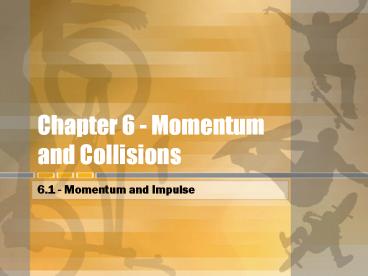Chapter 6 - Momentum and Collisions - PowerPoint PPT Presentation
1 / 19
Title:
Chapter 6 - Momentum and Collisions
Description:
Chapter 6 - Momentum and Collisions 6.1 - Momentum and Impulse Review Energy cannot be created or destroyed, but only changed from one form to another Newton s 3 ... – PowerPoint PPT presentation
Number of Views:184
Avg rating:3.0/5.0
Title: Chapter 6 - Momentum and Collisions
1
Chapter 6 - Momentum and Collisions
- 6.1 - Momentum and Impulse
2
Review
- Energy cannot be created or destroyed, but only
changed from one form to another - Newtons 3 laws
- Kinetic energy is the energy of motion KE1/2
mv2
3
Momentum and Impulse
- Momentum is a vector quantity defined as the
product of an objects mass and velocity - SI units are kilogram-meters per second
4
Momentum and Impulse
- A change in momentum takes force and time
- Impulse-Momentum Theorem
or
5
Momentum and Impulse
- Explains why follow-through is important in many
sports - Impulse is the product of the force and the time
over which it acts on an object - Determines stopping times and distances
6
Momentum and Impulse
- A change in momentum over a longer time requires
less force - Example
- The egg fall
7
HW Assignment
- Page 209 Practice 6A
- Page 211 Practice 6B
- Page 213 Practice 6C
8
Chapter 6 - Momentum and Collisions
- 6.2 - Conservation of momentum
9
Conservation of momentum
- We have looked at the momentum of one object
- If two or more objects are interacting with each
other then the total momentum of all objects
remains constant regardless of the nature of the
forces between the objects
10
Conservation of momentum
- Momentum is conserved in collisions
- Momentum is also conserved for objects pushing
away from each other
total initial momentum total final momentum
11
Chapter 6 - Momentum and Impulse
- 6.3 - Elastic and inelastic collisions
12
Perfectly inelastic collisions
- A collision in which two objects stick together
and move with a common velocity after colliding - After the collision, the two objects become
essentially one object
13
Perfectly Inelastic Collisions
- In this case, we get a simplified version of the
equation for conservation of momentum - using this equation, pay attention to the signs
indicating direction - What happens in terms of Kinetic Energy?
14
Perfectly Inelastic Collisions
- Consider the following Situation
- m1 1kg v1 5 m/s
- m2 2kg v2 3 m/s
15
Conservation of Momentum
- Video Demonstration
16
Practice Problem
- A clay ball with a mass of 0.35 kg hits another
0.35 kg ball at rest, and the two stick together.
The first ball has an initial speed of 4.2 m/s. - What is the final speed of the balls?
- Calculate the decrease in kinetic energy that
occurs during the collision - What percentage of the kinetic energy is
converted to other forms of energy?
17
Elastic Collision
- When two objects collide and return to their
original shapes with no change in momentum and no
change in total kinetic energy
18
Collisions
- Most collisions are neither elastic nor perfectly
inelastic - Even in nearly elastic collisions, there is some
deformation and loss of kinetic energy as a
result - In most collisions, some kinetic energy is
converted into sound
19
HW Assignment
- Page 224, Practice 6E 1, 3, 5
- Page 226, Practice 6F
- Page 229, Practice 6G 1, 3, 4

